The Confluence
fall/winter 2025
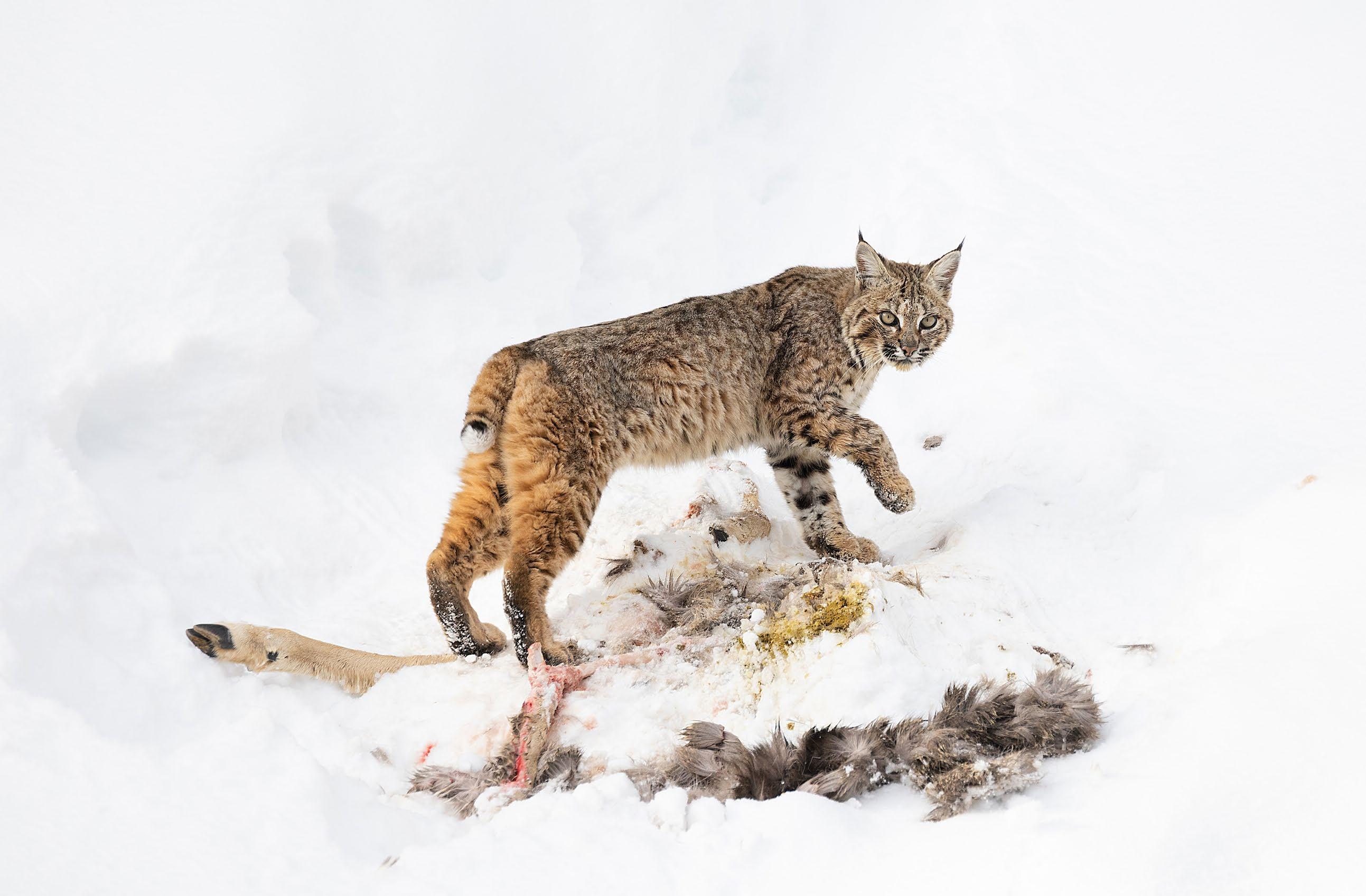


fall/winter 2025


If you want to go quickly, go alone. If you want to go far, go together. - African proverb
I stood in the relatively cool shade of a thicket of trees, sheltering from the heat, squinting up to see what birds were chittering away. I could see flickers of motion but was uncertain how many individuals there were or what I was hearing. Cassin’s and red-eyed vireos, red crossbills, chickadees, nuthatches and maybe a flycatcher. A raven. I am not a great acoustic learner, and every single year I am surprised and thrilled to learn what a robin sounds like. I know chickadees because they spend the winter with us and incessantly remind us what they sound like.

As I stood in the trees, curious how many species of birds were above and around me, I thought about how much we learn by listening rather than just hearing. A flock of birds making noise becomes different species calling for different reasons, telling us something new. These birds were sharing information and listening to all the voices in the forest in this mixed community. In this moment, in this place, I was part of that mixed group, and I could benefit from listening to each of these voices and learning more about what was around me. An alarm call….What was coming? I’ve worked in places where birds and other animal alarm calls were critical to my own wellbeing when we all faced a similar threat, like a snake or another predator. And as we learn more about the acoustic soundscapes of ecosystems, we learn that we can measure the health of entire systems by the sounds they make. Healthy systems are full of individual voices.
It is what we do best without realizing it; we belong to communities in this world where we speak and listen. We stand in forests and observe what plants and animals are there and what signs can tell us about what has happened. We learn from Master Naturalist classes and from our friends and our own quiet listening and observations. We tell others about the amazing bear tracks we saw and the elk we hear bugle. We run to our camera traps to see what animals have been there and see what they were doing. We share these with our human communities during Wild for Wildlife, and we can’t believe our eyes and ears at all the amazing behaviors captured on film when we weren’t watching. What are they telling us?
We talk about this place, the Swan Valley, with our friends, family, neighbors, colleagues, donors and the wider world, to share the reason we live and work here and why it needs our protection. We listen to what our community has to say about the watershed and what matters here. We join with agencies and other non-profits to make a stronger case for conserving our forests, waters and wildlife that cross watershed boundaries, as well as threats to the larger landscape like fire and poorly planned development. We listen and have conversations to promote, conserve and support our communities and all the diverse voices that make up the Swan Valley.
Community is the driving force behind all we do, and we strive to serve our people by sharing what we learn. We all have a different take on what we want. We vote differently. We eat and drink, recreate and relax differently. Yet when we listen and share our voices, we find ways to be a community of diverse interests and work together for what is important to all of us; there are so many things we all love about this special place.
Join your community in watching the secret lives of wildlife from our trail camera footage during Wild for Wildlife in October. Sit down, share a meal, and hear from the various speakers we bring in for our community potlucks and presentations. Share a recipe. Stop by our visitor center to gather resources and information,and share stories of your experiences out on the landscape.
Swan Valley Connections
P.O. Box 1309• Condon, MT 59826 p: (406) 754-3137
info@svconnections.org
Board of Directors
Jessy Stevenson, Co-Chair
Rich Thomason, Co-Chair/Secretary
Donn Lassila, Treasurer
Rachel Feigley
Carol Harwood
Neva Hassenein
David Holmes
Caitlin Jindrich
Maria Mantas
Jon Simon
Dan Stone
Aaron Whitten
Tina Zenzola
Emeritus
Russ Abolt
Steve Ellis
Melanie Parker
Tom Parker
Neil Meyer
Rebecca Ramsey In Memoriam
Anne Dahl
Advisors
Steve Bell
Jim Burchfield
Larry Garlick
Steve Kloetzel
Chris La Tray
Zoë Leake
Tim Love
Alex Metcalf
Casey Ryan
Mark Schiltz
Mary Shaw
Lara Tomov
Mark Vander Meer
Gary Wolfe Staff
Luke Lamar, Managing Director
Sara Lamar, Managing Director
Andrea DiNino
Kirsten Frazer
Mike Mayernik
Megan Parker
Jessica Reyes
Uwe Schaefer
Taylor Tewksbury
The Confluence is published by Swan Valley Connections, a non-profit organization situated in Montana’s scenic Swan Valley. Our mission is to inspire conservation and expand stewardship in the Swan Valley. Images by Swan Valley Connections’ staff, students, or volunteers, unless otherwise noted. All rights reserved to Swan Valley Connections. Change service requested. SwanValleyConnections.org
Cover: Bobcat on a deer carcass by Rebecca King, www.rebeccakingphotography.com
We’re proud to play a part in the group effort that it takes to steward a watershed. We clear trails and provide backcountry rangering and campsite cleaning so we can all get into the backcountry and see more of it. Go use these beautiful trails to hike, hunt and fish. We provide electric fencing to keep your property safe from bears and bears safe from trouble. Call us if you need help keeping bears and people safe. We assess your forests and advise you how to keep it healthy, while supporting wildlife and reducing wildfire risk. Invite us over to look at your property and talk about what you want and need. We listen. We cut and deliver firewood for those who rely on the forest’s wealth for their winter warmth. We are a community that serves our people. Come to a talk, a work party, a bear safety training, a volunteer day, a class…and share your thoughts and stories.
We gather to do all this and more for and with our communities, human and non-human. It is an act of belonging. Like a flock of birds, we find community among a diversity of voices and we find direction by listening. A healthy ecosystem sounds like many, many different voices. Please be a voice for the Swan Valley.
Better Together,

Megan Parker, Development Director


Another way you can support SVC is through our web shop and visitor center! We’ve got some exciting new merch (including kids’ tees and books!), and more on the way... just in time for the holidays.

October 1-31, 2025
GOAL: $75,000
All gifts of $500 or more will be matched 1:1 thanks to the Cinnabar Foundation and a generous, anonymous donor

The health of an ecologically intact ecosystem is reflected in the abundance and diversity of living things. That’s why we proudly say we’re wild for wildlife. Every program and service we offer is deeply connected to the animals that share this landscape with us, and it’s your support that makes this work possible.
This October we’re excited to share some of our favorite trail camera videos from the past year, capturing candid moments and rare glimpses into the everyday lives of the Swan Valley’s wildlife. Follow us on social, sign up for our emails, or join us at one of our in-person movie nights to experience the wonder right alongside us!
www.SwanValleyConnections.org/wild-for-wildlife
Neva Hassenein has co-owned a cabin on Pierce Lake in the upper Swan Valley since 2015, and lives in Missoula. She is retired from a career as a professor in the Environmental Studies Program at the University of Montana. Her work has focused on creating more sustainable, community-based food systems, and on farmland protection and land use planning. She’s also passionate about hunting wild mushrooms and other outdoor pursuits.


Since 2009 Carol Harwood and her husband have enjoyed living on Swan Lake on property owned by the family since 1978. Retired from various careers as an engineer and project manager, she has served on a number of nonprofits, boards, and commissions. She has enjoyed many of Swan Valley Connections’ classes and looks forward to continued stewardship of the Swan Valley.

We first became acquainted with Swan Valley Connections when a tree fell on our roof ten years ago. SVC was able to supply us with a list of loggers who could help. With a heavily treed property and some large trees very close to our buildings, we soon realized that our small forest (7 acres!) needed attention if we wanted to avoid future problems. We worked with SVC for forest management ideas and took forest stewardship classes to best understand our options. We soon realized the impact that simple changes could have on helping with fire mitigation on our property.
By thinning the forest on our property, we not only reduced our wildfire risk, but we can also now see wildlife casually strolling through the area, and we can give them the wide berth they desire. In addition to the forest stewardship opportunities, we appreciate the educational classes in wildlife tracking, which have helped us to better identify the wildlife in the hood and understand the importance of removing and containing all attractants.
We’re lucky to have a few very towering ponderosa pines on our property. Curious about their age, we had a forester core them, revealing them to be 300-500 years old! A couple of them that stand along the lake shore have large

burn scars, telling us that fire once made it all the way down to the water, long before our cabin stood on the property. These trees have clearly been through a lot, and we wanted to do whatever we could to keep them resilient and standing long into the future, so we also started purchasing bubble caps (aka pheromone packets) from SVC for beetle mitigation.
I appreciate SVC’s commitment to education about issues that impact the entire Swan Watershed and the way that they value hearing all perspectives and finding common ground. The more informed visitors and residents are about the challenges on this landscape, what makes this place so unique, and the resources available to them, the better we can all care for this land and its inhabitants for generations to come. This long-term approach and perspective is vital to the resilience of this wild and special place.
Over the years, we’ve considered how we could give back to and support the organization that has given so much to us, and one thing we’ve found to work well for us is the donation of stock. By making an easy transfer to the organization, it gives us the value of a donation without the tax implications of capital gains. We see the wonderful work these dollars support (even more so now that I’m on the board!), and we hope you’ll find the way that works best for you to support this group of hardworking, dedicated, and caring individuals.

From the entire staff and board, thank you for making our 2025 Summer Soirée in the Swan (hosted at the stunning Oro Ranch in Condon) such a beautiful and successful event this summer!
In 2025:
• 15 students were awarded scholarships
• Over $23,000 of scholarship funds were awarded
• We received over $62,000 of scholarship requests
With your help, going into 2026, we raised over $34,000 in scholarships for future students! This includes gifts that were donated to the recently-created Anne Dahl Legacy Scholarship Fund (which you are still welcome to donate to!).
Hear from one of our scholarship recipients below to learn about the impact your generosity has on these students’ lives!

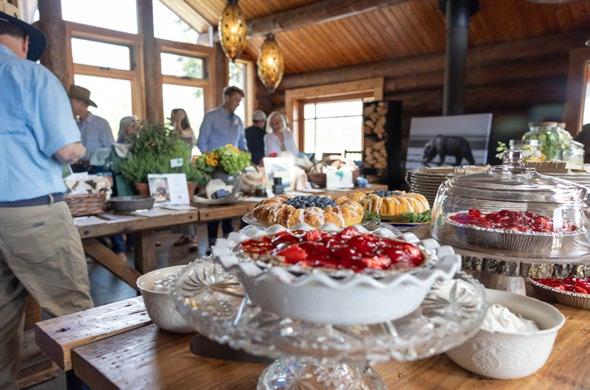
Rekindling a Passion for Wildlife: Sydney’s Scholarship Story
“Hi, my name is Sydney Wolf. I’m currently a student at the University of Montana, but I’m originally from a suburban region near Portland, Oregon. I have always wanted to work in a field where I would interact with wildlife, so I came to study wildlife biology. The fire to learn about animals and explore in the field had somewhat died after close to 2 years of sitting in a classroom; I wasn’t even sure if I wanted to continue on with my major. Walking around through the forest, applying the knowledge I learned in lectures, and just truly understanding what it’s like to learn in the field lit that dying ember inside me. And though I still don’t know where I am headed career-wise, this course was able to rekindle my love for learning about wildlife, helped me trust in myself and my dreams, and encouraged me to keep pursuing a major in wildlife biology.
However, all of this was only possible due to the support of the scholarship I was granted. If I were given the chance to tell the person who gave me this opportunity something, I would say: thank you.
Thank you, from the bottom of my heart, for making it possible for me to attend this course. Without it, I wouldn’t be on the life path I am on now, I wouldn’t have the connections and confidence I have, and I never would have looked at the world with invigorated wonder at all the subtle signs that surround me. In the end, I hope that one day, another student like me, someone low on funds, or someone struggling with the direction they want to take their life, or someone whose love and spark has dimmed, finds this course, like I did, and is given the opportunity to grow and learn without the concern of not having enough funds. Thank you again to the Swan Valley Connections team and to the generous donors who allowed me and helped me go on this journey of learning, growth, and progress.”
Opposite page, left: The Harwoods’ thinned forest, which not only reduces wildfire risk, but also allows them to see the wildlife moving through their property.
Opposite page, right: A fire scar on a hundreds-of-years-old ponderosa pine along the shore of Swan Lake, showing that wildfire made it all the way down to the water at some point in time.

Celebrating 50 years of Montana’s 310 law
By
Working for a conservation district in Montana is a little different than in any other state in the country. In Montana conservation districts have regulatory authority, as well as an obligation to educate, provide technical assistance, and enter into cost-sharing agreements with landowners looking to promote conservation features on their land. Here, conservation districts are also in charge of overseeing the Montana Natural Streambed and Land Preservation Act of 1975, also known as the 310 Law. The 310 Law requires anyone who is doing work that could impact or alter a stream or its banks, including the riparian buffer (the highly diverse area between a stream and drier upland areas), to get a permit before such work begins. There is one exception: beavers.
Beavers are the original architects of the river. They harvest vegetation in the riparian area, dig into the banks, and dam whole streams—all activities requiring a 310 permit. Landowners who want to have a manicured bank are often frustrated that beavers’ work gets done without a 310 permit. Sometimes I joke with these landowners complaining about beavers and their unpermitted work, and let them know that we take such violations very seriously. In fact, sometimes the beaver activities are punishable by death. Of course, not by the conservation districts; even with landowner violators— where we do have the ability to levy fines up to $5,000 a day for unpermitted activities—we try to work with people to have them restore nature before we take punitive measures. The poor beavers are not always so lucky.
All that being said, restoration ecologists are emulating the beaver more and more. We are manipulating banks to activate floodplains and allow the ground to get saturated with water, only to release it slowly back to the creek in the hot summer during periods of low water. We are adding woody
structures to rivers to create complexity of habitats, providing hiding places for fish and food for the aquatic invertebrates on which they feed. We even have a term for mimicking a beaver dam—BDA (beaver dam analogs)—which not only helps to put water into the soils for storage, but also traps sediment behind them, building up incised stream bottoms and creating splash pools of clean gravel. All of the beaver mimicry does require a 310 permit, even though the work is being done with the best of intentions. The law is regulation, and although the permit is free, it is another step to take for anyone working around a stream. Well, anyone, except beavers.
So this year, the 50th anniversary of the 310 Law, let’s celebrate what nature does. Let’s stop trying to control the world around us and literally go with the flow and let things rewild a bit. We don’t need to clear our riparian areas to make lawns and then spend our weekends mowing those lawns— in fact, that is illegal. Let’s enjoy watching the wild around us and learn about the ecosystem services that land provides. It is good to be industrious, but let’s leave that riparian grooming to the work of the busy beaver.

This past July, Swan Valley Connections (SVC) and the Confederated Salish and Kootenai Tribes (CSKT) unveiled a shared project that was years in the making, on a property that we’ve proudly co-managed for many more years than that. With over 60 guests in attendance, including Condon locals, Tribal Elders, Missoula County commissioners, the Mission Mountains Youth Crew, and others, we presented our new educational kiosk on the Elk Creek Conservation Area.
Made up of four large wooden panels, the kiosk highlights SVC as an organization; the CSKT and the cultural significance of this landscape, its wildlife and plant life; the Montana Legacy Project and history of the Swan Valley; and the Elk Creek Conservation Area (ECCA) itself. Revealing one panel at a time, different speakers shared the history of this special section and stories of the many people who have long used this land, stewarded it, and made an impact on its conservation.
Stephanie Gillin, Information and Education Program Manager with CSKT and ECCA Kiosk project member, said, “We

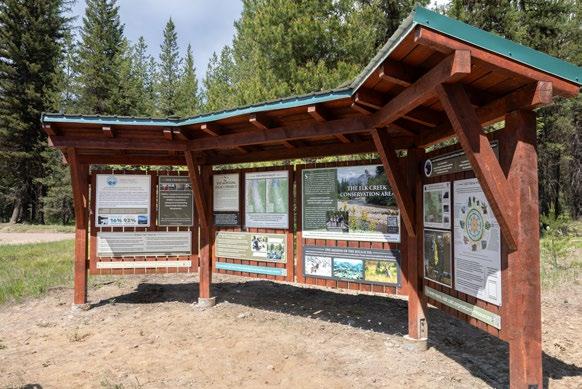
do have strong ties. I remember stories from my yaya, talking about them riding horseback over into the Swan Valley to hunt...We are very honored to be part of this project and work with the management team. We put together a representation of what cooperative management looks like, how we can make that possible.”
After the presentation and a shared lunch, which was blessed by one of the Mission Mountains Youth Crew leads, everyone was invited on a short hike down to Elk Creek. With bear rub trees, elk antler rubs, coyote scats, and more sprinkled along the way, it wasn’t hard to think about how different this section could look had it been sold to developers, or to feel immense gratitude for the collaborative effort that led to its protection.
SVC continues to co-manage the the ECCA with the CSKT and use it for all of our experiential education classes. Learn more about the history, management plan, and public use regulations at www.swanvalleyconnections.org/elk-creekconservation-area
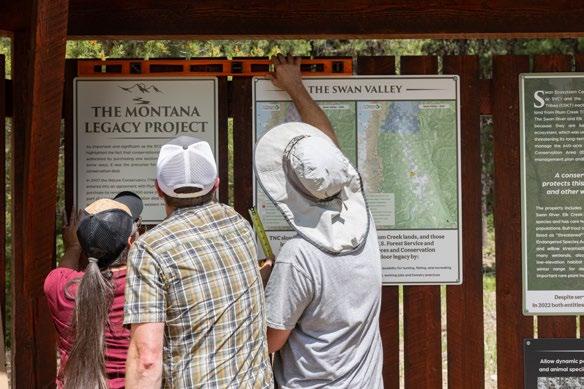
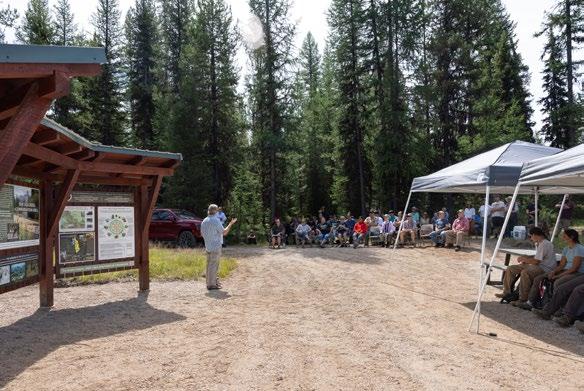

“Anne Dahl and my mother both had the same build –short and thin. But as my mom used to say, “Dynamite comes in a small package but produces a big bang.” And when I think of it, that epitomizes what Anne Dahl meant to this valley. She was a good listener, smart, persistent, and got things done, all while being one of the nicest human beings on this earth. She was perfect for the formative years of the Swan Ad Hoc Committee and Swan Ecosystem Center. Many great things happened while Anne led the charge on so many projects and the Swan Valley is a better place for all her efforts. If the rest of us would only do a fraction of what she accomplished, we could say we lived a good life. She certainly did, a life led by example.” -Steve Lamar, shared at Anne’s posthumouslypresented Missoula County Land Stewardship Award in July 2025
This past June, with great respect and admiration, SVC and Vital Ground presented the 2025 Bud Moore Conservation Award to Anne Dahl, a woman whose life’s work embodies Bud Moore’s enduring philosophy: “Listen to the Land.”
After a brief battle with cancer, Anne passed away at her Swan Valley home, surrounded by her loving family on June 30, 2025; she has left an enduring conservation legacy in the Swan and has inspired countless people along the way.
The Bud Moore Conservation Award was established in 2012 to honor and help perpetuate Bud’s legacy. Presented collaboratively by SVC and Vital Ground, with guidance from Bud’s children, Bill and Vicki Moore, the award recognizes individuals who:
• Work in Western Montana’s landscapes—including the Swan, Seeley, Blackfoot, Clark Fork, Lolo, Bitterroot, or Flathead regions— whether in a professional or volunteer capacity.
• Demonstrate deep partnership with rural communities in natural resource conservation.
• Embody leadership, holistic thinking, and the spirit of cooperation.
Through decades of tireless effort, Anne Dahl has built bridges between people and the land— between residents, agencies, and nonprofits—with a steady hand, a clear voice, and an open mind. Her work reflects Bud Moore’s belief in respectful dialogue, ecosystem management, ecological humility, and a commitment to working together for the land’s future. Like Bud, Anne understood that conservation is not only about protecting ecosystems, but also about fostering trust and stewardship across boundaries, generations, and communities.
Anne moved to the Swan Valley with her family in 1982. An early member of the Swan Citizens’ Ad Hoc Committee, formed in 1990, Anne worked alongside an unlikely alliance of loggers, conservationists, developers, outfitters, old-timers, and newcomers—all determined to focus on shared values rather than divisions. When the U.S. Forest Service (USFS) announced plans in 1996 to close the Condon Work Center, the ad hoc committee responded by forming a nonprofit: the Swan Ecosystem Center (SEC). Anne, with her growing skills in grant writing and consensus-building, was hired as SEC’s first executive director.
That same year, when wilderness ranger contracts in the Mission Mountains and Swan Front lost full Forest Service funding, SEC led a successful community cost-share fundraising effort to keep rangers on the ground in partnership with the USFS. This early effort set the tone for Anne’s leadership— adaptive, collaborative, and rooted in community values. Under Anne’s direction, SEC launched and supported numerous stewardship initiatives. These included:
• Partnering with the Forest Service to keep the Condon Work Center and visitor center open.
• Securing funds for private landowners to conduct wildfire fuels reduction work.
• Helping landowners combat invasive species through support from the Missoula County Weed District.
• Collaborating with U.S. Fish and Wildlife Service on wetland restoration and waterfowl counts.
• Improving native fish habitat by reducing sediment runoff from roads through Montana DEQ funding.
• Providing outdoor education and after-school programs for local youth.
• Helping launch Swan Valley Bear Resources, a collaborative effort between SEC, Northwest Connections, USFS, DNRC, and other partners to promote coexistence between people and grizzly bears.
In 2002 a turning point came when Plum Creek Timber Company announced the potential sale of large tracts of land in the Swan Valley. Concerned about the loss of wildlife habitat, timberlands, and public access, SEC—under Anne’s leadership—mobilized quickly. Working with the Forest Service, DNRC, University of Montana, Montana Fish, Wildlife & Parks, and others, SEC identified high-value conservation parcels, including Section 35, at the confluence of Elk Creek and the Swan River.
Initially valued at $9.6 million, Section 35 was threatened by private development. Anne discovered that the Confederated Salish and Kootenai Tribes (CSKT) were seeking to reclaim ancestral lands and fish habitat, and together, SEC and CSKT jointly acquired Section 35. This section became known as the Elk Creek Conservation Area, which remains open to the public and co-managed by SVC and CSKT to this day.
“That’s when everybody realized we couldn’t protect land in the Swan one square mile at a time,” Anne recalled. That realization laid the groundwork for the Montana Legacy Project. Through years of negotiation, The Nature Conservancy and the Trust for Public Land purchased 310,000 acres of Plum Creek forestlands across northwest Montana, including 67,000 acres in the Swan Valley. The result was permanent protection for forests, waters, and wildlife habitat, while maintaining working lands and public access. Most of this land was ultimately transferred to the Forest Service and DNRC.
Anne also served on Missoula County’s Open Space Advisory Committee for many years, helping secure open space bond funding that has enabled private land conservation easements to reach fruition that may not have been possible without bond funding.
Anne was the executive director of SEC for 16 years, before retiring in 2013, but her legacy continues to shape the Swan Valley. Her impact is not just visible on maps and trails, but is deeply felt in the hearts of the people and wildlife who call this place home.
As Bill and Vickie Moore beautifully shared:
“The Swan Valley spoke to Anne, and she heard its messages. She learned the landscapes, hiked the trails, bushwhacked, flung herself into the rivers and lakes on hot summer days, camped under the stars, skied through the snowy winterscapes, listened to the birds and insects, knew the local plant communities, understood ecosystems, forestry and watersheds, listened to the people, and recognized their needs and desires. She anchored in the Swan. It became her country. She put down her roots here, and her influence on the valley will always be felt.”
Anne was interviewed by Steve and Sharon Lamar in February 2023 as part of the Upper Swan Valley Historical Society’s Oral History Project. The interview was then summarized by Sharon Lamar into a chapter for the next Voices of the Swan book.


Above: Anne’s granddaughter, Anna, looking at the contents of a scat with Sara Lamar; Anna became a certified Montana Master Naturalist through SVC this past August!
Opposite page: Anne created a weekly cartoon based on James Fenimore Cooper’s “Natty Bumpo” for the Seeley Swan Pathfinder newspaper, producing over 600 cartoons from 1986 to 1999. The whimsical cartoons were a tongue-in-cheek commentary about life in the Swan Valley. Subject matter for the cartoons included garbage-loving bears, cattle drives down the highway, ballgames at the USFS airstrip, and hikes in the backcountry.
By Sara Lamar
I often enter the woods for solitude. There are a few times, however, while alone on my walks, that I feel as if I’m being watched. One of those instances turned out to be a mountain lion (that’s another story), but more often when I stop to look around, I find an enormous pair of eyes staring down at me from 10 feet up a tree. These eyes belong to an owl, usually a great horned, great gray, or barred. Look into an owl’s eyes and you’ll feel as though they see straight through you. While owls don’t have X-ray vision, their eyes do take up 60% to 75% of their skull volume, giving them extraordinary vision. Combine that with their silent flight, and it’s no wonder they feel magnetic, mysterious, and even otherworldly.
But despite their mystical aura, owls are not immune to danger. Beyond natural threats like starvation or predation, they face many human-caused risks. Vehicle collisions are a well-known source of mortality. This summer, however, we encountered two sobering examples of another, lesser-known threat: barbed-wire fences.
The first call we received was a great horned owl caught in a barbed-wire fence. Our very own Andrea DiNino was able to respond, remove the owl from the fence, and transport it to Wild Wings Recovery Center in Kalispell. The second report came from a volunteer with our Great Gray Monitoring Project. A neighbor had discovered the remains of a female great gray owl that was tangled in their fence. All that was left were feathers and a leg band, placed years earlier by the Owl Research Institute (ORI). Great grays are especially vulnerable, as they prefer to hunt in grassy meadows that are often used by horses and cattle and enclosed by barbed-wire fencing.
ORI was able to identify the individual by her leg band, and conservation photographer Melissa Groo recalled her visits to the Swan and her experiences with this particular owl:
“In May ‘23 and June ‘25 I photographed this female great gray owl at her nest in the same broken-topped snag, in a dense conifer forest in Swan Valley, Montana. The first year, she had two tiny chicks, still so fresh, I only briefly glimpsed their bright white heads. This year, in early June, I found her with three chicks: one had just fledged and two were on the verge.
This was an adept, experienced mother. Intensely vigilant, she interrupted any activity—preening, resting, tending to her young—to focus on possible threats: a high-flying raven, the alarm of a red squirrel, my shifts on the forest floor. I will never forget that piercing, unwavering gaze she’d fix on me. It contained the clear message that she’d seen me, and would brook no trespass. (I never approached the nest, and stayed at least 60 yards away.)
And then there was her hunting prowess. Once, in a 40-minute period, she headed off nearby to hunt three times (I could glimpse her hunting through the trees), each time swiftly returning with a rodent. Made up of 70% feathers as all great grays are, she was always silent in flight.
Once in ‘23, while brooding her chicks, she fell into a deep sleep, face turned upwards as if in worship to the sky. This is the moment that above all else stays with me, that I return to
in my mind over and over again. I reveled in her surrender, her vulnerability, and in the absolute serenity and sanctity of this deep, verdant nursery. I felt there must be nothing as pure and true as this animal and this place.
It’s why I mourn her loss so much.”

Over the years, Brooke Tanner of Wild Skies Raptor Center in Potomac, Montana, has treated 32 raptors that became entangled in fences. Of course it’s not just birds of prey that become injured in these fences, they can also block movement or prove fatal for many other species of wildlife. Crisscrossing both private and public lands, fences in Montana likely extend for tens of thousands of miles. While no official statewide tally exists, the scale is unmistakable. Fences are essential for managing livestock and, in some cases, for keeping wildlife away from attractants. Fortunately, there are practical ways to build fences that meet human needs while also reducing risks to wildlife.
Montana Fish, Wildlife & Parks provides a valuable resource, A Landowner’s Guide to Wildlife Friendly Fences, which offers straightforward, actionable advice:
Height Matters: Keep fences under 40 inches tall to allow large
Increase visibility with a PVC cover, high-visibility wire, flagging, or a top rail

The friendliest fences are very visible and allow wild animals to easily jump over or slip under the wires or rails
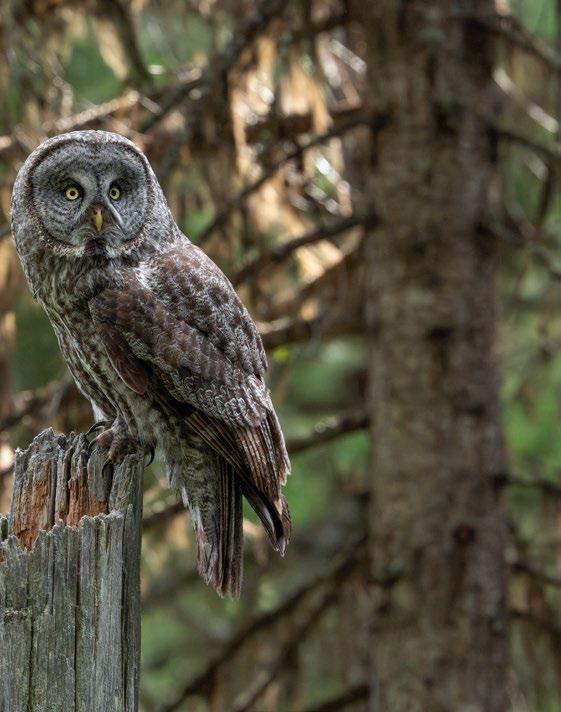
Center image: The great gray female and her chicks. Photo by conservation photographer Melissa Groo (www.melissagroo.com)
Below left: The remains of the same great gray owl, found late this summer.
Below right: A great horned owl caught in a barbed wire fence earlier this summer. Luckily the landowners found the owl alive and called for help, and it was able to fully recover at Montana Wild Wings Recovery Center in Kalispell.
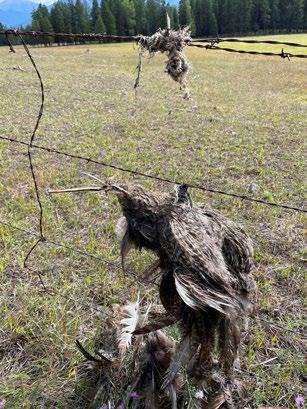

Adjustable Features: In known migration zones, incorporate gates or removable sections that can be easily modified seasonally
ungulates to clear them easily, while ensuring the bottom stands at least 18 inches above ground to let both smaller animals and big game crawl beneath.
Smooth Wire is Safer: Where possible, use smooth, not barbed, wire for top and bottom strands. This greatly reduces the chance of severe injuries when animals jump or crawl. A smooth top wire is critical for birds of prey that may land. You can alternatively cover the barbs with split PVC pipe or poly pipe to create a smoother surface. Trim or remove excess, unused, or loose wire.
Increase Visibility: Add high-visibility markers such as flags, ribbons, or bright tape to the top wire to make the fence more visible.
Wide Spacing Between Wires: Leave at least 12 inches between the top wires so animals don’t get entangled
*To discourage birds from landing on fences, consider constructing wooden perches in fields where owls hunt, either away from fences or just taller than fence posts around it. These recommendations are for large-scale fences that are designed to contain horses or cattle. Electric exclusion fences that are designed to keep bears or other predators out of attractants have different requirements. If you have questions about fencing, feel free to contact us at info@svconnections. org or 406-754-3137. You can access FWP’s guide at https://fwp. mt.gov/conservation/wildlife-management/wildlife-migration/ private-lands/fence-modification or stop by our office for a hard copy. If you have unused, dilapidated barbed wire fencing on your property, please contact us, as we may be able to connect you with resources to remove it.
Wildlife-friendly fencing is an accessible, compassionate, and practical solution. By adopting thoughtful design, landowners can reduce wildlife mortality, maintain ecological connectivity, and reduce fence damage, protecting both their resources and Montana’s wildlife. Whether it’s a slight adjustment to spacing, swapping in smooth wire, or partnering to remove old fencing, every step counts. As the owls’ stories remind us, even seemingly small barriers can have dire consequences. But with awareness and action, we can foster a landscape where both people and wildlife flourish.
By Dillon Tabish, Regional Communication & Education Program Manager for MT Fish, Wildlife, & Parks
In summertime, we all know what to do if we see smoke in the forest – report it. Quick detection helps fire crews respond swiftly and keep the fire from growing into a bigger problem. It’s the same for bear conflict specialists. The sooner they know about a problem involving a bear, the better chance they have addressing it before it becomes worse for everyone.
Living in Montana, we share our landscapes with wildlife. Encounters between humans and bears come with the territory here. However, when these situations escalate into conflicts, prompt reporting to Montana Fish, Wildlife & Parks (FWP) is critical. Waiting for the problem to resolve itself often leads to worse outcomes for both people and bears, while early reporting opens the door to effective solutions. FWP has staff ready to respond, and their expertise can prevent conflicts from spiraling out of control.
Bears are intelligent, adaptable creatures driven by survival instincts. A bear that finds an easy meal, like unsecured trash, pet food, or a poorly stored cooler, will likely return. This is a conflict that only worsens if not addressed properly. What starts as a single incident can quickly become a pattern, putting people, property, and the bear itself at risk. By the time a bear becomes conditioned to human food sources, it may require more drastic intervention, including relocation or, in some cases when the problem is too severe, euthanasia. Early reporting allows FWP to step in before the situation escalates, protecting both human safety and wildlife.
FWP’s bear management specialists are trained to handle conflicts with practical solutions tailored to the situation. When you report a bear sighting or conflict, FWP can assess the situation and implement measures like securing attractants, installing electric fencing, or using non-lethal deterrents to discourage the bear from returning.
Some Montanans hesitate to report bear conflicts, fearing it will automatically lead to the bear’s death. This is a misconception. FWP’s primary goal is to manage wildlife in ways that protect people and keep bears wild. By reporting early, you give FWP specialists the chance to intervene before a bear becomes too habituated, increasing the likelihood of a positive outcome for everyone. Waiting too long often limits these options, as a bear that repeatedly associates humans with food becomes a greater safety risk.
Don’t wait for a bear conflict to “fix itself.” It rarely does. Instead, call your local FWP office or visit their website to report conflicts promptly. Early action is the key to solutions that work for everyone—human and bear alike.
FWP recently debuted a new Grizzly Bear Conflict Dashboard as a resource for information on where FWP staff are helping landowners and communities with conflicts and the types of conflicts people are experiencing. View the dashboard online at https://fwp.mt.gov/conservation/wildlifemanagement/bear.


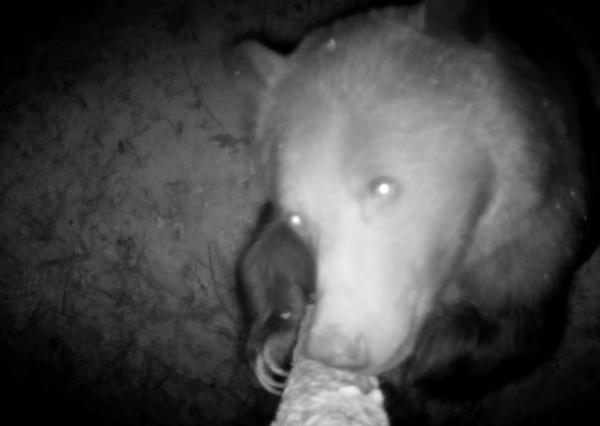
By Luke Lamar
Overall, human-bear conflicts have been minimal in the Swan River Watershed in 2025 compared to other years. The natural berry crop, such as huckleberries, serviceberries, and chokecherries, was very good on a landscape-scale this year. Typically, in years when natural food sources are widely available throughout the summer and fall months, this helps keep bears away from people’s homes where there’s a potential for obtaining unnatural food sources (garbage, chickens, livestock grain, pet food, etc) and getting into conflict with humans. Conversely, in years where there is a poor berry crop, humanbear conflicts typically increase.
However, just because it’s been a good berry crop, doesn’t mean people should become lackadaisical with containing their bear attractants. When bears are in hyperphagia, packing on calories and building body fat during the fall months (in preparation for winter hibernation), this can often lead to an increase in human-bear conflicts. Autumn brings late summer drought, the first frost, and snow, making it harder to find rich and reliable food sources. Residents in the Swan River Watershed’s communities of Condon, Swan Lake, Ferndale, and Bigfork should always assume both black and grizzly bears are in their areas and remain diligent about containing their attractants while bears are awake, which is typically about March 15th through December 15th.
Unfortunately, human-bear conflicts do occur on the landscape, and when they do, it is imperative for residents to report these conflicts to Montana Fish, Wildlife & Parks Bear Management Specialists right away. This allows specialists the opportunity to provide solutions before a bear becomes habituated to being around people’s homes and gaining access to the variety of foods that can be obtained, if not properly secured. Once a bear becomes habituated, it can be food conditioned to human foods, rather than seeking out natural foods on the landscape, and lead to dangerous situations and safety concerns for humans and their neighbors.
In August and early September, there was a rash of bear conflicts in the Condon area, with a grizzly bear (or bears) who had received too many human foods, and by the time some residents started to report these conflicts to FWP Bear Management Specialists, the bear had developed the habit of breaking into chicken coops, sheds, garages, and eventually homes. This escalated behavior could have potentially been avoided if residents had reported early conflicts to FWP before
Opposite page (from top to bottom):
A 2025 Wildlife in the West student helping to build an electric fence in Ferndale to protect goats.
Bear spray next to an apple-filled pile of bear scat in the Swan this fall.
A trail camera image of a female grizzly bear sniffing a bear rub tree this summer.
the bear became food conditioned to human foods. Once things reach this point, it’s too late and there aren’t any options left for the bear other than removal. The irony is that in some cases people don’t want to report a single conflict to FWP because they don’t want the bear to get in trouble and be removed. Solutions that FWP or partners with Swan Valley Bear Resources can provide are: free property visits to offer advice on a variety of ways to secure bear attractants; free bear-resistant trash cans; or free help constructing (and securing cost-share funding for) electric fences to secure attractants like chickens, orchard trees, livestock and their grain, and more. A properly built (to certain specifications powerful enough to deter a grizzly bear) and well-maintained electric fence is extremely effective at keeping bears from accessing these attractants. Unfortunately, there has been one documented grizzly bear mortality in the Swan Watershed this year, which was the result of a defense of life shooting, when a landowner was charged by a male grizzly who was going after livestock. USDA Wildlife Services and SVC are currently working with this landowner to provide solutions to secure chickens, pigs, and livestock grain with electric fencing.
FWP has created an online grizzly bear mortality dashboard and a conflict dashboard, where anyone can view the locations of conflicts and mortalities in Montana each year. See https://fwp.mt.gov/homepage/news/2025/aug/0827-beardashboards to access these dashboards.

• SVC has built 14 permanent electric fences, helping to secure bear attractants including chickens, goats, livestock grain, orchard trees, compost piles, and gardens
• SVC has distributed 24 bear-resistant trash cans. We just received an order of 85 cans, available for free to anyone in the Swan Watershed
• SVC worked with Montana Department of Natural Resources and Conservation (DNRC) to place 2 bear boxes (for campers and bicyclists to store food in at night) at the Point Pleasant and Soup Creek Campgrounds
• SVC hosted or attended 21 bear awareness education events, reaching over 835 people
• SVC contacted all landowners and businesses who own a bear-resistant dumpster and fixed several broken dumpsters
• Living with Wildlife Foundation’s Swan Valley Bear Ranger interfaced with over 300 people at US Forest Service and DNRC campsites; she shared information about Leave No Trace camping, food storage orders, recreating and camping safely in bear country, and proper use of bear spray. The Bear Ranger removed approximately 70 bags of garbage from developed and dispersed campsites and extinguished 4 abandoned campfires.
• We hired 1 new Bear Conflict Prevention Coordinator; meet Jessica on the next page!
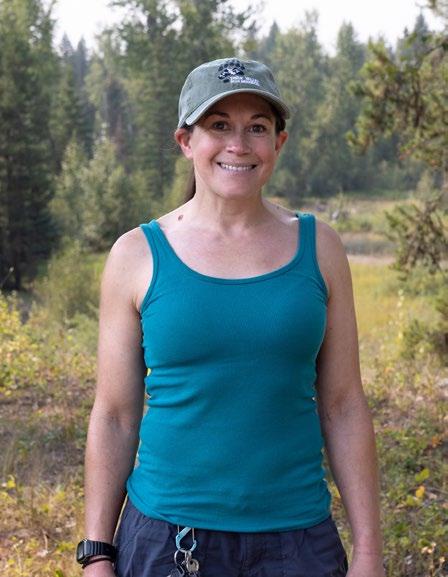
Meet our new Bear Conflict Prevention Coordinator
Originally from the sierras of Northern California, Jessica (she/her) grew up in a wildland-urban interface, where people and wildlife intersected, inspiring a passion for human-wildlife conflict mitigation.
After receiving a bachelor’s in Wildlife Management and Conservation, Jessica went on to work as a seasonal wildlife tech in Colorado before moving to Montana and interning with the Wind River Bear Institute. She worked with Montana Fish, Wildlife & Parks, focusing on bear-aware education and assisting with conflict responses in the Bitterroot.
From there she earned her M.S. in Geography, with a focus on Community & Environmental Planning. For her thesis, Jessica mapped black bear conflicts and prevention efforts in western Montana.
When she’s not working, you can find Jessica tracking, backpacking, or hiking with her Karelian bear dog, Joni. She also likes to hunt, fish, and mountain bike, exploring the beautiful mountains and lakes of western Montana whenever she can!
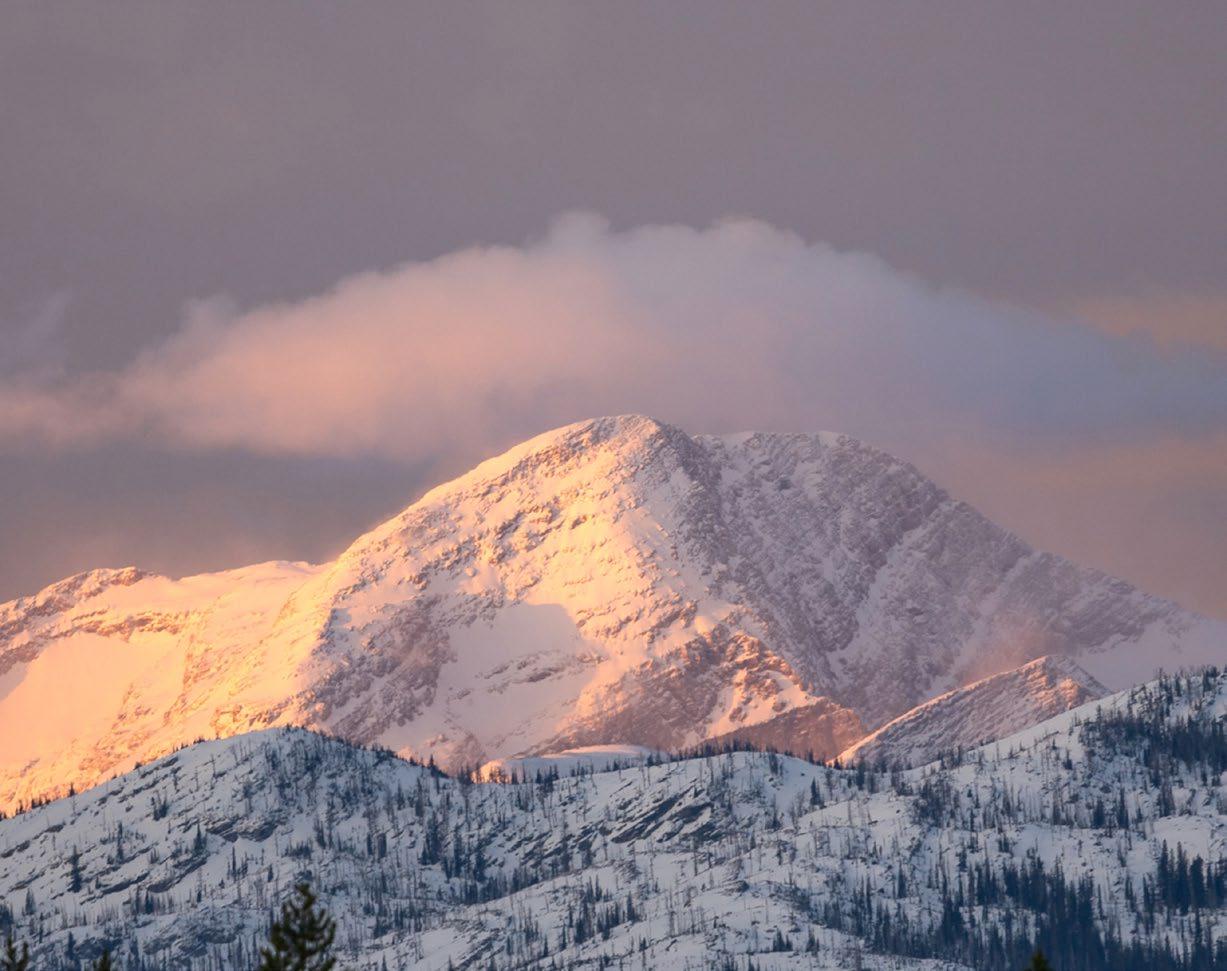
2025 was also the 50th anniversary of the Mission Mountains Wilderness designation. We shared an article written by Kay Bjork for the Flathead Beacon this summer in which Kay shares the history of both the mountains and the humans who traveled in them, as well as current-day use and stewardship. You can find the link for “A Mission Mountain Milestone” on the Pressroom page of our website! Here’s an excerpt: “Fifty years ago, 73,877 acres of the Mission Mountains area were designated as wilderness… Nathan Noble has been a wilderness ranger with Daughter of the Sun Backcountry Services (DOTS) for the past 11 years, and Luke Lamar was a wilderness ranger for 12 years before he began working full time at Swan Ecosystem Center and then at Swan Valley Connections, where he is administrator of the DOTS contract. Both men grew up playing on different sides of the mountain — Noble on the west side, accessed from his Polson home; and Lamar on the east side, while growing up near Condon. They developed an intimate relationship with the Mission Mountains Wilderness as they roamed the backcountry as if it was their big backyard. Their paths intercepted when they both grew up to be stewards of this spectacular place that framed their childhoods and ended up determining their futures...”
Huge thanks to Daughter of the Sun Backcountry Services this year! Due to reduced Forest Service staff, capacity, and funding, NO TRAILS would be cleared or maintained in the Mission Mountains Wilderness or Swan Front this year without SVC’s Trail Stewardship Program and the work of DOTS.
Ensure the Swan remains wild & resilient for future generations

Impactful Ways to Give:
• Deferred Gift Annuity
• Donating to our Endowment Fund with Montana Community Foundation (MT taxpayers get 40% tax credit)
• Donating Stock (avoiding capital gains while maximizing charitable impact)
• Life Insurance Policy Donations (potentially large future gifts with modest current premiums)
• Charitable Remainder Trusts (providing income streams to donors while benefiting the endowment)
• Memorial and Honor Gifts (allowing families to create lasting tributes)
• IRA Qualified Charitable Distributions (also receiving tax benefits)
• Bequest to SVC in your will
More 2026 events to be added
Always check our website for the most up-to-date information!
1-31: Wild for Wildlife Match Campaign
2: Annual Community Firewood Day
18-19: Women’s Chainsaw Workshop
21: Pile Burning Workshop with Montana DNRC
23: “Where the Wild Things Are” Trail Cam Movie Night at A Bar (Ferndale)
27: “Where the Wild Things Are” Trail Cam Movie Night at The Roxy (Missoula)
29: Swan Lands Coordinating Network Public Meeting
November
5: Quarterly Potluck: Road Ecology
12: Bear Trivia Night at Flathead Lake Brewing Co
december
1: Winter Programs Scholarship Application Deadline
21 & 23: Annual Audubon Christmas Bird Count & Zoom Tally
2026
january
2-10: Weeklong Wildlife Tracks & Sign Course and Certification
12: Bubble Cap Orders Open
15: Spring Programs Scholarship Application Deadline
24: One-day Wildlife Tracks & Sign Class
february
4: Quarterly Potluck: Conservation Detection Dogs
7: Wildlife Tracks & Sign Family Day
15: Summer Programs Scholarship Application Deadline
28: One-day Wildlife Tracks & Sign Class
•Late February-Mid-April: Owl Monitoring with Owl Research Institute (Volunteer Opportunity)
7: One-day Wildlife Tracks & Sign Class
13: Bubble Cap Orders Close
14-22: Weeklong Wildlife Tracks & Sign Course and Certification
APRIL
1: Quarterly Potluck: Spring Bear Wake-up Social
May
1: Annual Adopt-a-Highway Cleanup (Volunteer Opportunity)
9: Birds & Buds Walk, A Global Big Day Celebration
18: Wildlife Trailing Workshop
18-June 27: Wildlife in the West
30-31: Wildlife Trailing Standard Certification (w/ Nate Harvey)
30-31: Wildlife Tracks & Sign Standard Certification (w/ David Moskowitz)
June
6-7: Wildlife Tracks & Sign Standard Certification (w/ David Moskowitz)
July
5-13: Weeklong Wildlife Tracks & Sign Course and Certification
20-25: Montana Master Naturalist Course

Condon, MT 59826-9005

